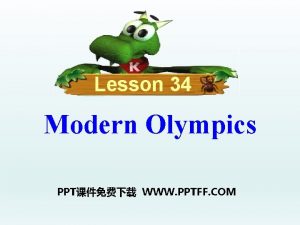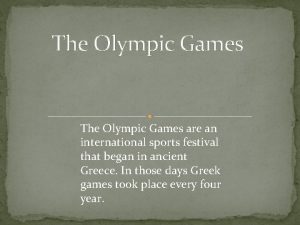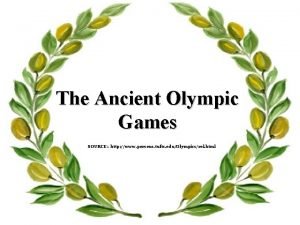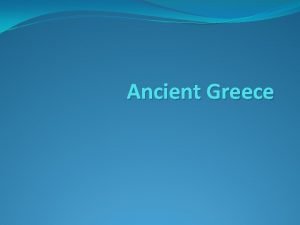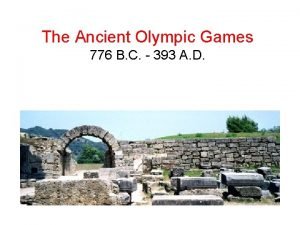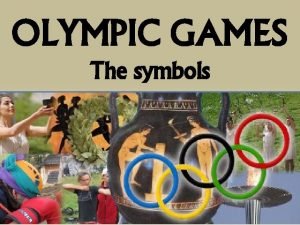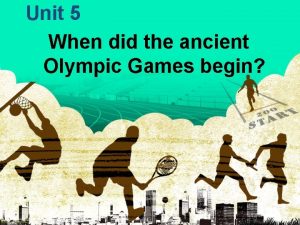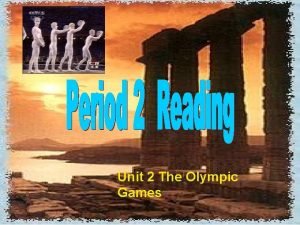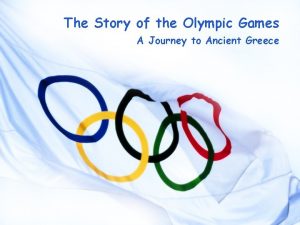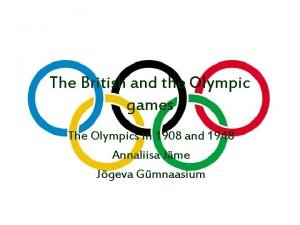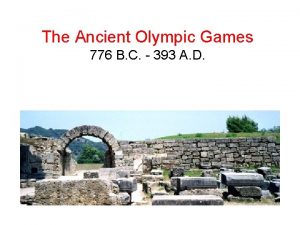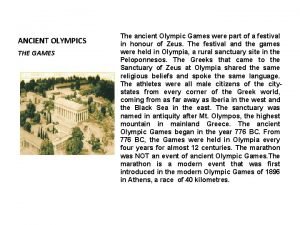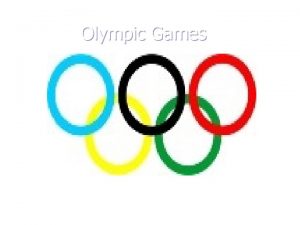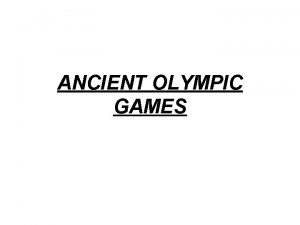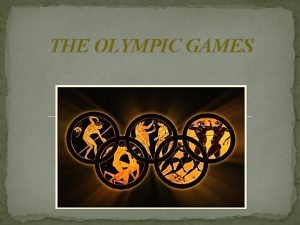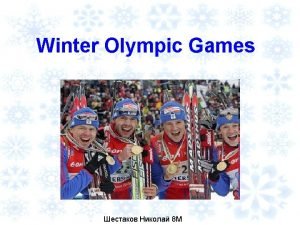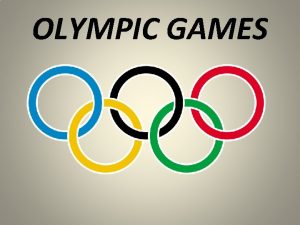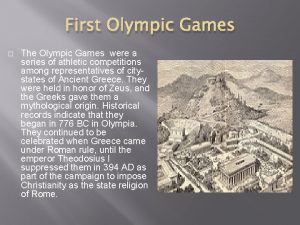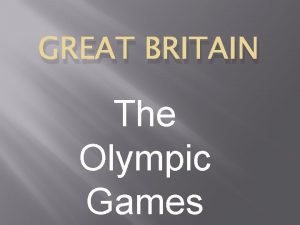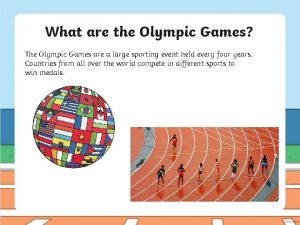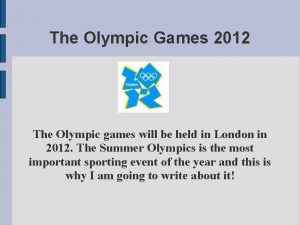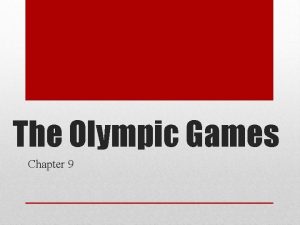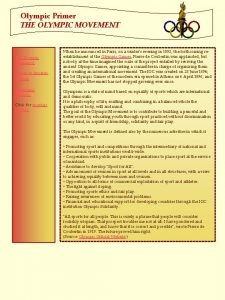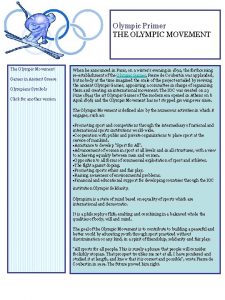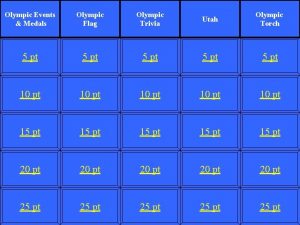THE MODERN OLYMPIC GAMES 1 HISTORY 2 THE



















- Slides: 19


THE MODERN OLYMPIC GAMES 1. HISTORY 2. THE OLYMPIC MOVEMENT : PHILOSOPHY AND SPORTSMANSHIP. 3. WHAT DO THE OLYMMPIC RINGS MEAN? 4. FLAME AND TORCH 5. THE OLYMPIC OATH. 6. RINGS AND FLAGS 7. ANTHEM. 8. RELEASE OF DOVES. 9. WHAT IS THE OLYMPIC CREED 10. THE VICTORY CEREMONY. 11. CLOSING STATEMENT. 12. MODER OLYMPIC GAMES: VIDEO.

THE MODERN OLYMPIC • Coubertin believed that GAMES could inspire a feeling of unity and peace among the many nations of the world. • In 1894 at an international congress. • The International Olympic Committee (IOC) was founded that year 1894. • Held in Athens in 1896 at the Panatheniac Stadium. • The Olympics have taken place every four years, since the first games in 1896. • The Winter Olympic Games were introduced in 1924. • Since the first modern Olympic Games in Athens in 1896, the games have continued to grow throughout the years and more nations have been taking part, as well as more events being included.

The Olympic Movement • The Olympic Movement is a philosophy created and promoted by the International Olympic Committee. This philosophy advocates using sport not just as a physical activity but also as a means of educating people. • The good sportsmanship, sense of fair play, and respect for fellow athletes that is developed through participation in sports teaches men and women of different races, religions, and nationalities to work peacefully together in competition toward common goals.

What do the Olympic rings mean? • The colours of the interlinked Olympic rings were chosen by the International Olympic Committee (IOC), to represent the union of the 5 continents, Australia, Africa , America , Asia and Europe and further signify the meeting of the worlds athletes at the Olympic Games. • The plain white background of the Olympic flag is symbolic of peace throughout the games. • The five colours of the rings from left to right are blue, black and red across the top with yellow and green along the bottom , these colours may be found on most flags of the world and officially hold no other particular significance , although some believe each colour represents a particular continent. Blue =Europe Yellow =Asia Black =Africa Green =Australia Red =America

Flame and Torch

The Olympic Oath

The Olympic Oath “In the name of all the competitors I promise that we shall take part in these Olympic Games, respecting and abiding by the rules which govern them, committing ourselves to a sport without doping and without drugs, in the true spirit of sportsmanship, for the glory of sport and the honor of our teams. "

Rings and Flag

Anthem Immortal spirit of antiquity Father of the true, beautiful and good, Descend, appear, shed over us thy light Upon this ground and under this sky Which has first witnessed thy unperishable fame Give life and animation to those noble games! Throw wreaths of fadeless flowers to the victors In the race and in the strife! Create in our breasts, hearts of steel! In thy light, plains, mountains and seas Shine in a roseate hue and form a vast temple To which all nations throng to adore thee, Oh immortal spirit of antiquity!

Motto The Olympic motto is Citius—Altius—Fortius, which is Latin for "faster, higher, stronger. " The motto has been with the Games from the foundation of the International Olympic Committee in 1894. It was proposed by the father of the modern Olympic Games, Pierre de Coubertin, who got it from a speech given by a friend of his, Henri Didon, a Dominican priest and principal of an academy that used sports as part of its educational program.

Release of Doves • After the cauldron is lit, doves are released, as a symbol of peace. This was first done in the 1896 Olympics, and then in the 1920 Olympics. • Since 1920, this has been an official part of the Opening Ceremony of the Summer Games. The order—first lighting the cauldron, then releasing the doves—is important. In the 1988 Seoul Games, they tried it the other way around. Unfortunately, many of the doves were in the area of the cauldron just before it burst into flames, leading to their unexpected demise.

Seoul 1988 Roast Doves!!!!

What is the Olympic creed? The Olympic creed was first stated in 1896 by the founder of the modern Olympic games , Baron Pierre de Coubertin , the words of the creed are as follows: The most important thing in the Olympic Games is not to win but to take part, just as the most important thing in life is not the triumph but the struggle. The essential thing is not to have conquered but to have fought well. "

The Victory Ceremony At the Ancient Games, winners were presented with a simple olive tree branch which was cut with a gold-handled knife from a wild olive tree. The Greeks believed that the vitality of the sacred tree was transmitted to the recipient through the branch. At the Modern Games, Olympic medals are presented to the winning athletes who stand on a dais at the completion of their event. A GOLD medal is presented for first place, SILVER for second and BRONZE for third. The host city is responsible for designing the medals within the guidelines set by the IOC. The national anthem of the winner is played as each medalist’s national flag is raised.

Closing statement

Closing Ceremony

MODERN OLYMPIC GAMES

Thanks
 Modern olympic games ppt
Modern olympic games ppt Olympics ppt template
Olympics ppt template The olympic games are an international sports festival
The olympic games are an international sports festival Origin of olympic games
Origin of olympic games Ancient greece olympics opening ceremony
Ancient greece olympics opening ceremony 776 bc first olympic games
776 bc first olympic games The ancient olympic games were initially:
The ancient olympic games were initially: Citius, altius, fortius means
Citius, altius, fortius means Class five english question answer
Class five english question answer Ancient olympic games
Ancient olympic games Unit 2 games
Unit 2 games Ancient olympic games
Ancient olympic games The first olympic games were held in olympia in the year
The first olympic games were held in olympia in the year Olympic games athens
Olympic games athens The olympic games is an international reading answers
The olympic games is an international reading answers Annaliisa jäme
Annaliisa jäme The ancient olympic games were initially
The ancient olympic games were initially Ancient olympic pentathlon
Ancient olympic pentathlon Chapter 13 hunger games questions
Chapter 13 hunger games questions Types of games indoor and outdoor
Types of games indoor and outdoor
